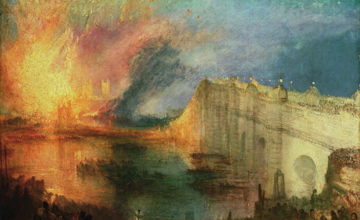J.M.W. Turner’s Paintings and 9/11
J.M.W. Turner’s Paintings and 9/11
9/11 and J.M.W. Turner’s Paintings
With 165 works, the majority of them oils and watercolors, the current exhibit of the English painter J. M. W. Turner at New York’s Metropolitan Museum of Art qualifies as a blockbuster. But the exhibit, which lasts through September 21 and is the first major retrospective in America devoted to Turner, has not won uniform praise. Reviewers have complained that the sight of so many Turners in one place reminds them of his repetitiveness.
It is a tough charge to beat. Turner began exhibiting at the Royal Academy in 1796, when he was just 21, and he was productive for the next 50 years. It is hard to think of any artist with such a large body of work who would not repeat himself. It is as if what really bothers Turner’s American critics is the time it takes to absorb his work.
That’s too bad. One of Turner’s great strengths is that the painting he did in the first half of the nineteenth century provides a lesson in art history. When we look at his historical painting “The Battle of Trafalgar as seen from the Mizen Starboard Shrouds of Victory” (1806), we are reminded of Benjamin West. When we look at his “The Temple of Jupiter Panellenius Restored” (1816) with its landscape dominated by buildings from antiquity, it is Claude Lorraine who comes to mind. When we look at his meticulously rendered “Venice: The Dogana and San Giorgio Maggiore” (1834), we think of Canaletto. When we look at his use of light and color in “Peace–Burial at Sea” (1842), we see the impressionism of Claude Monet.
 There is no pinning Turner down to a single style or subject. The essential Turner is many Turners, each in competition with the others. In December 1851, as he lay dying in London, Turner observed, “So I am to become a nonentity, am I?” The opposite was the case. But Turner’s dying fear, despite a lifetime of success, reflects his towering ambition and the reason why he pushed himself so hard in so many different directions.
There is no pinning Turner down to a single style or subject. The essential Turner is many Turners, each in competition with the others. In December 1851, as he lay dying in London, Turner observed, “So I am to become a nonentity, am I?” The opposite was the case. But Turner’s dying fear, despite a lifetime of success, reflects his towering ambition and the reason why he pushed himself so hard in so many different directions.
It would be a mistake, however, to conclude that Turner lacked a central core simply because he was such a diverse painter. As the Met exhibit, which has already been to the National Gallery of Art in Washington and the Dallas Museum of Art, shows, Turner consistently painted a world in which human effort amounts to little. This is true for his many seascapes, in which storms continually bring about shipwreck, as well as for his masterpieces, “The Burning of the Houses of Lords and Commons, October 16, 1834” ( both 1835), in which fire lights the London sky and is reflected in the Thames while obscuring the Houses of Parliament.
In an America still traumatized by 9/11, Turner’s fascination with such disasters and his outward lack of concern for those caught up in them seem at first glance cruel. Small wonder that in his review of the Met’s Turner exhibit, John Updike observed, “Turner didn’t see human beings as worth much in the balance of things.” We need only think of the anger that would be directed against any contemporary artist who painted the World Trade Towers on 9/11 by focusing on the smoke billowing from them rather than on the human tragedy of that day.
And therein lies the critical difference between our times and Turner’s. In our age of terrorism, as in the preceding years of the Second World War and cold war, the most destructive forces we have faced are man-made. These forces speak to a world built on hubris and conquest. By contrast, in Turner’s world nature still has the upper hand when it comes to power, and to be reminded of that imbalance in his paintings is anything but cruel or dehumanizing on his part. It is instead the Victorian lesson in humility that underlies his work.
Nicolaus Mills, a professor of American Studies at Sarah Lawrence College, is the author of Winning the Peace: The Marshall Plan and America’s Coming of Age as a Superpower. Painting (“The Burning of the Houses of Lords and Commons, 16th October 1834,” Philadelphia Museum of Art, The John Howard McFadden Collection) courtesy of the Metropolitan Museum of Art.






